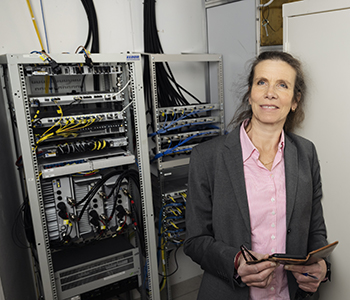How mobile users can help keep the network up during a power cut
Maria Jonsson, KTH alumna and Head of Network

If there’s a power cut in Sweden, mobile operators have to keep their masts running using temporary backup power to ensure that coverage does not disappear immediately. But the masts can still go down quickly, partly due to excessive network load.
“Mobile users’ behaviour has a major impact on calling and browsing capability when there’s a power cut,” says KTH alumna Maria Jonsson, Head of Network at mobile operator Tre.
According to Maria Jonsson, Tre, one of the biggest mobile operators in Sweden, is well equipped to keep the mobile network up and running as required in the event of a power cut.
“We’re constantly working to replace old batteries with new ones, and to ensure that we have sufficiently high battery capacity at all our thousands of base stations across Sweden.”
What other measures have been taken to increase operational reliability?
“Our most central nodes in the core network, whose role it is to manage and control all the base stations, are duplicated and located at different physical locations. If one node goes down, the traffic is automatically redirected to the mirrored node, which could be tens of kilometres away.
“The same principle applies for the entire fibre network. The network is built in ring structures, so if for example a fibre is dug out, the network traffic is turned around to minimise the impact on the traffic.
“We also regularly test the network at night, and deliberately interrupt the traffic to make sure that all the safety measures are working properly,” Jonsson adds.
"Primarily use text messaging"
One risk scenario in which mobile users’ behaviour can affect the network’s function is if the fibre network in an apartment building stops working due to a power cut.
“At times like that, a lot more people probably connect to the mobile network, which can quickly become overloaded as all the digital communication switches over simultaneously,” says Jonsson.

“In that situation, a lot of people think that their laptop or phone will carry on working until the battery runs out. Few people consider that the base station the mobile is connected to also needs power and has limited battery capacity, and that centrally too there’s a risk of overload.”
What should mobile users do to avoid burdening the network unnecessarily when there’s a power cut or other emergency?
“My main advice would be to primarily use text messaging if you need to communicate. That’s better than calling. Texting puts less of a burden on the network than calling, and it’s also more likely that the message will be sent if the network’s seriously overloaded, for instance in an emergency.”
She adds that text messaging is less sensitive to temporary delays than a voice call, which requires an active connection throughout the call.
“But in an emergency situation when the network gets overloaded because too many people are calling and browsing at the same time, we always prioritise emergency calls to 112,” says Jonsson.

Avoid mobile video during power cut
She also stresses the fact that videos require huge amounts of mobile data.
“Watching a video, or filming a video and posting it on social media when there’s a power cut, is definitely not ideal.”
When Maria Jonsson graduated from KTH in Electrical Engineering in 1992, 2G was being launched. Since then she has been involved in the launch of 3G, 4G and 5G.
Her next job is to build the technology for the smart, sustainable cities and autonomous vehicles of the future.
“It’s great to be able to work on societal issues and areas of progress that have an important human link. There’s a sense of pride in feeling we’re doing something important for society.”
Katarina Ahlfort
Photo: Mikael Sjöberg
